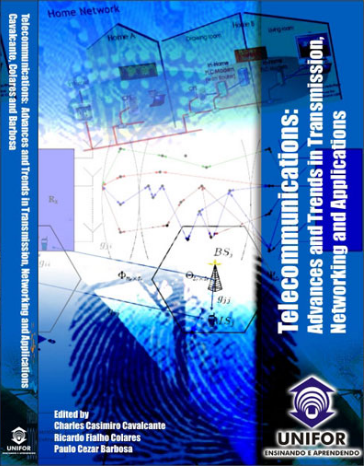Charles Casimiro Cavalcante
Professor
Telecommunications: Advances and Trends in Transmission, Networking and Applications, Networking and Applications

This book is copyrighted by University of Fortaleza (UNIFOR - Edson Queiroz Foundation). UNIFOR has kindly allowed to place a copy on the web, as a reference and for ease of web searches. Click on the link for pdf file, ~200 pages.
Precise reference:- Charles Casimiro Cavalcante, Ricardo Fialho Colares and Paulo Cezar Barboza (Eds.), Telecommunications: Advances and Trends in Transmission, Networking and Applications. University of Fortaleza Press, UNIFOR, Fortaleza-Brazil, 2006 (189+xi pages, ISBN 85-98876-18-6)
- Bibtex file for the book, including page numbers for each chapter and other reference data.
Introduction
This book is aimed at the advanced level and is suitable for graduate students and researchers. The material can be used as advanced special topics to be used for independent study, for example, an introduction for graduate students who wish to conduct research in the areas covered by the chapters of the book. Engineers may appreciate the up-todate tutorial exposition to timely topics. Some technologies reviewed here are being (or even already) incorporated into commercial systems.
Table of contents
Chapter 1 - Information Theory and Wireless Channel Modeling
Mérouane Debbah
- Introduction
- Some Considerations
- Gaussian i.i.d Channel Model
- Knowledge of the directions of arrival, departure, delay, bandwidth, power: frequency selective channel model with time variance
- Discussion
- Testing the Models
- Conclusion
Chapter 2 - Unsupervised Signal Processing: Concepts, Applications and Trends
Ricardo Suyama, Leonardo T. Duarte, Aline Neves, Rafael Ferrari, Romis R. F. Attux, Charles C. Cavalcante, Cynthia Junqueira, João Marcos T. Romano
- Introduction
- Equalization/Deconvolution: Single-Input / Single-Output (SISO) Systems
- Multichannel and Multiuser Systems
- Blind Source Separation
- Equalization: Going further
- Blind Source Separation: Going Further
- Blind Equalization and Blind Source Separation: Some Important Relationships
- Modern trends
Chapter 3 - Tensor Decompositions and Applications to Wireless Communications Systems
André L. F. de Almeida, Gérard Favier, João C. M. Mota
- Introduction
- Background on Tensor Decompositions
- Applications of Tensor Decompositions to Wireless Communications
- Summary
Chapter 4 - Power Control for Wireless Networks
Raimundo A. de Oliveira Neto, Fabiano de S. Chaves, F. Rodrigo P. Cavalcanti, Ricardo B. dos Santos
- Introduction
- Models and Basic Definitions
- Centralized Power Control
- Distributed Power Control
- Feasibility and Convergence Aspects
- Semi-distributed Power Control Algorithms
- Techniques of Transmitter Removal
- Techniques of SINR-target decreasing
- Practical aspects of power control
- Power Control in WCDMA
- Power Control for Multirate Systems
- Power Control Games
- Prediction for Improvements of Power Control
- Conclusions
Chapter 5 - Crosslayer Techniques - Theory and Application
Benno Zerlin, Josef A. Nossek
- Overview
- A generic scheme
- Some applications
- Conclusion
Chapter 6 - Power Line Communications: A Promising Communication System's Paradigm for Last Miles and Last Meters Applications
Moisés Vidal Ribeiro
- Introduction
- Historical Perspective
- Channel Models
- Additive Noise
- PL Channel Equalization with Fuzzy Techniques
- Mitigation of Impulsive Noise
- Channel Coding
- Multi-Carrier, Spread Spectrum, and Single-Carrier
- Multiple Access
- Impact on Video, Image, and Audio Transmission
- Concluding Remarks
Chapter 7 - New Trends in Biometrics
Bernadette Dorizzi
- Introduction
- Overview of technical challenges: An already established technology still under development
- Description of different biometric modalities
- Evaluation of biometric systems
- Conclusion
Chapter 8 - Modeling of Complex Photonic Structures Devices and Applications
Vitaly F. Rodríguez-Esquerre, Hugo E. Hernández-Figueroa, M. Koshiba
- Introduction
- Modal Analysis of 2D Photonic Crystal Structures
- Modal Analysis of 2D Photonic Crystal Waveguides
- Analysis of 2D Photonic Crystal Cavities: Time and Frequency Domains
- Power splitters for waveguides composed by ultralow refractive index metallic nanostructures
- Frequency Dependent Envelope Finite Element Time Domain Analysis of Dispersive Materials and Metallic Structures Operating at Optical Frequencies
- Implicit and Explicit Frequency-Dependent Finite-Element Time-Domain FETD Methods for Metallic Nanostructures Analysis
- Numerical Platform for Band Gap Computation
- Applications, Future Work and Trends
- Conclusions
